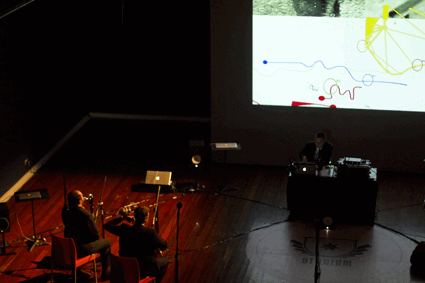 |
Decibel performing Talking Board, THNMF 2011 photo © Brad Serls |
Visuality plays an enormous role in the interpretation of sound and vice-versa. In film, dance, theatre, games and live music visual and sonic textures intermingle, each feeding the other. The tendency is toward a direct relationship. In film, for example, music is used principally to heighten the emotional content of a scene. However Camera Obscura explored musical works with a more dynamic relationship between sound and image.
The first piece, Mothlight, by NSW composer Austin Buckett is inspired by a Stan Brakhage silent short film from 1963. As Brakhage did not want his silent films to be accompanied by music, the sound and image are isolated from one another. The musicians play flute, percussion and synthesiser tones which flutter, insect-like, about four speakers. A blank screen and large film projector onstage cast the players in a light of anticipation.
After a short pause in the performance the film projector whirs into life and Brakhage’s Mothlight plays while the performers sit in silence. The film is gorgeous—red silhouettes of moths skittering in grainy handmade animation. We recall the sonic textures, the remembered performance becoming the film’s soundtrack. The shimmer of percussion, the whir of the projector and the quivering moths of the film combine in an insect hum.
The next piece, Talking Board, is a collaboration between Decibel members Cat Hope and Lindsay Vickery. The score is a huge composite image of various drawings and photographs projected onto the screen at the back of the stage, which the performers also face. Four circles representing the four instruments (bass clarinet, bass flute, cello and viola) move about the image instructing players as to which section of the graphic to read. The notation is all asemic—not prescribing any specific meaning in terms of pitch, rhythm etc but rather implying a sonic texture. The conversation between sight and sound in the piece is beautiful. Jackson Pollock-inspired drippings and alien landscapes are answered by percussive murmurings and velvety drones.
In Talking Board, the score itself is allowed a voice in the performance. The circles move according to their own rules of chance and logic. This creates a mobile form, where no two performances will repeat and the performers are no more certain of the next move than the listener. The shared drama of such a form is a big part of what makes this piece so involving for the audience.
Samuel Dunscombe’s West Park adopts a similar mobility. A fully notated score for clarinet and flute is pulled apart and randomly rearranged. The live sound of the instrumentalists is mixed with field recordings made at West Park Asylum in Epsom, UK. The visual element of this piece is mostly imagined whereas the field recordings are directly referential, describing the world in exact terms. Particularly when such loaded material is used, the sounds conjure instant and vivid imagery. The live instruments heighten the experience, creating an immersive and unsettling event.
Next was recent WAAPA graduate Kynan Tan’s piece, Split Mirror Planes, featuring four live performers, four speakers and four visual sources (networked laptops whose screens were visible to the audience). The eye is drawn around the space as various flashes and abstract motifs are passed between the laptops. Spatialising audio is by now a fairly common technique in new music but spatialised visual material is something I have not seen before. The sound and images here do not merely reflect one another but rather create a sonic-visual counterpoint, constantly in motion toward or away from each other.
The final piece of the night was White Lines by Marina Rosenfeld, who joined Decibel, playing turntables. The piece uses a film score with two parallel white lines changing width and opacity to direct subtle shifts in sound. The background of the film used much more concrete imagery than the other films of the night, with footage of flowers, cigarettes and churches all tied together by the visual motif of the white lines.
Connotation is a huge part of Rosenfeld’s work. The associations of imagery and sound take on more complex meaning when they are juxtaposed. White lines suggest associations ranging from division to purity to cocaine and it is interesting to see how these all play off one another. One particularly intriguing section involved delicate swelling sounds from percussionist Stuart James superimposed over footage of an 80s glam rock band at full fervour, their teased hair and pelvic thrusts taking on some surprising new connections.
Sound and imagery create a feedback loop. Image directs the way that one hears sound just as sound frames one’s reading of imagery. Such relationships have existed forever. What Decibel has done in Camera Obscura is to foreground these relationships. What the audience is left with is a fuller sensory experience: sight and sound as a dynamic conversation.
Totally Huge New Music Festival 2011: Decibel, Camera Obscura, performers Cat Hope, Lindsay Vickery, Stuart James, Malcolm Riddoch and Tristan Parr, with Marina Rosenfeld supported by Tura New Music, Perth Institute of Contemporary Arts, Sept 19; http://www.tura.com.au/totally-huge-music-festival/about
Henry Andersen is a composer and performer of new music, living in Perth. He is currently studying toward a Bachelor of Music Technology and Composition at the West Australian Academy of Performing Arts. Henry’s interest in music traverses a wide number of styles and he has been involved in music for live performance, sound installation, dance, film and other mixed media.
RealTime issue #106 Dec-Jan 2011 pg. 39
© Henry Andersen; for permission to reproduce apply to [email protected]








 back
back